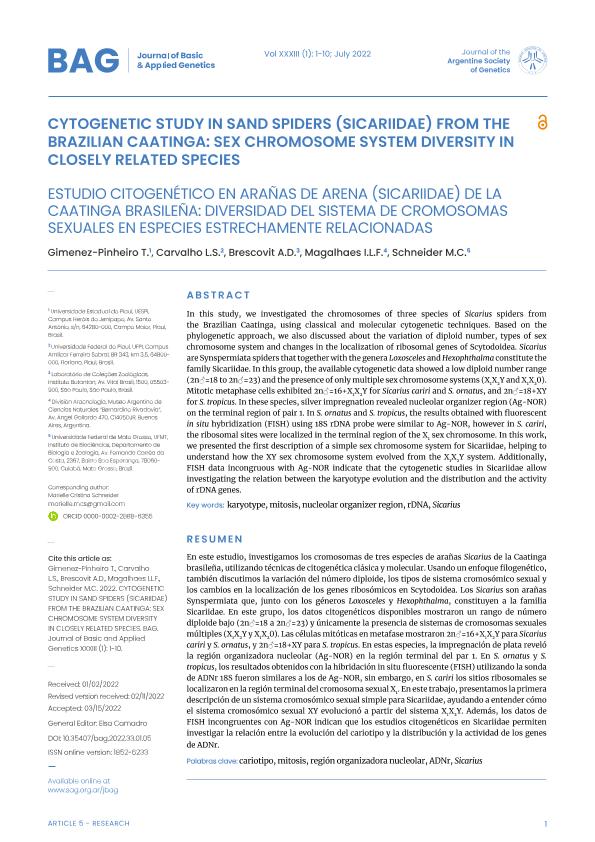Artículo
En este estudio, investigamos los cromosomas de tres especies de arañas Sicarius de la Caatinga brasileña, utilizando técnicas de citogenética clásica y molecular. Usando un enfoque filogenético, también discutimos la variación del número diploide, los tipos de sistema cromosómico sexual y los cambios en la localización de los genes ribosómicos en Scytodoidea. Los Sicarius son arañas Synspermiata que, junto con los géneros Loxosceles y Hexophthalma, constituyen a la familia Sicariidae. En este grupo, los datos citogenéticos disponibles mostraron un rango de número diploide bajo (2n♂=18 a 2n♂=23) y únicamente la presencia de sistemas de cromosomas sexuales múltiples (X1 X2Y y X1 X20). Las células mitóticas en metafase mostraron 2n♂=16+X1 X2Y para Sicarius cariri y S. ornatus, y 2n♂=18+XY para S. tropicus. En estas especies, la impregnación de plata reveló la región organizadora nucleolar (Ag-NOR) en la región terminal del par 1. En S. ornatus y S. tropicus, los resultados obtenidos con la hibridación in situ fluorescente (FISH) utilizando la sonda de ADNr 18S fueron similares a los de Ag-NOR, sin embargo, en S. cariri los sitios ribosomales se localizaron en la región terminal del cromosoma sexual X1 . En este trabajo, presentamos la primera descripción de un sistema cromosómico sexual simple para Sicariidae, ayudando a entender cómo el sistema cromosómico sexual XY evolucionó a partir del sistema X1 X2Y. Además, los datos de FISH incongruentes con Ag-NOR indican que los estudios citogenéticos en Sicariidae permiten investigar la relación entre la evolución del cariotipo y la distribución y la actividad de los genes de ADNr. In this study, we investigated the chromosomes of three species of Sicarius spiders from the Brazilian Caatinga, using classical and molecular cytogenetic techniques. Based on the phylogenetic approach, we also discussed about the variation of diploid number, types of sex chromosome system and changes in the localization of ribosomal genes of Scytodoidea. Sicarius are Synspermiata spiders that together with the genera Loxosceles and Hexophthalma constitute the family Sicariidae. In this group, the available cytogenetic data showed a low diploid number range (2n♂=18 to 2n♂=23) and the presence of only multiple sex chromosome systems (X1X2Y and X1X20). Mitotic metaphase cells exhibited 2n♂=16+X1X2Y for Sicarius cariri and S. ornatus, and 2n♂=18+XY for S. tropicus. In these species, silver impregnation revealed nucleolar organizer region (Ag-NOR) on the terminal region of pair 1. In S. ornatus and S. tropicus, the results obtained with fluorescent in situ hybridization (FISH) using 18S rDNA probe were similar to Ag-NOR, however in S. cariri, the ribosomal sites were localized in the terminal region of the X1 sex chromosome. In this work, we presented the first description of a simple sex chromosome system for Sicariidae, helping to understand how the XY sex chromosome system evolved from the X1X2Y system. Additionally, FISH data incongruous with Ag-NOR indicate that the cytogenetic studies in Sicariidae allow investigating the relation between the karyotype evolution and the distribution and the activity of rDNA genes.
Estudio citogenético en arañas de arena (Sicariidae) de la caatinga brasileña: Diversidad del sistema de cromosomas sexuales en especies estrechamente relacionadas
Título:
Cytogenetic study in sand spiders (Sicariidae) from the brazilian caatinga: Sex chromosome system diversity in closely related species
Gimenez Pinheiro, T.; Carvalho, L.S.; Brescovit, Antonio Domingos; Fiorini de Magalhaes, Ivan Luiz ; Schneider, M. C.
; Schneider, M. C.
 ; Schneider, M. C.
; Schneider, M. C.
Fecha de publicación:
07/2022
Editorial:
Sociedad Argentina de Genética
Revista:
Basic and Applied Genetics
ISSN:
1666-0390
Idioma:
Inglés
Tipo de recurso:
Artículo publicado
Clasificación temática:
Resumen
Palabras clave:
Karyotype
,
Mitosis
,
Nucleolar organizer region
,
rDNA
,
Sicarius
Archivos asociados
Licencia
Identificadores
Colecciones
Articulos(MACNBR)
Articulos de MUSEO ARG.DE CS.NAT "BERNARDINO RIVADAVIA"
Articulos de MUSEO ARG.DE CS.NAT "BERNARDINO RIVADAVIA"
Citación
Gimenez Pinheiro, T.; Carvalho, L.S.; Brescovit, Antonio Domingos; Fiorini de Magalhaes, Ivan Luiz; Schneider, M. C.; Estudio citogenético en arañas de arena (Sicariidae) de la caatinga brasileña: Diversidad del sistema de cromosomas sexuales en especies estrechamente relacionadas; Sociedad Argentina de Genética; Basic and Applied Genetics; 33; 1; 7-2022; 61-70
Compartir
Altmétricas



